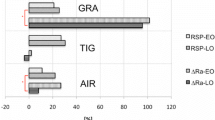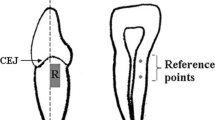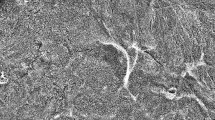Abstract
Ultrasonic and power-driven instrumentation is gaining in significance as an acceptable alternative to manual periodontal root treatment. Some question whether they do not remove too much tooth substance. Various ultrasonic scalers, hand instruments and two power-driven systems were compared by assessing the loss of tooth substance due to root instrumentation. Quantitative analysis of this effect of the instruments used was performed on 20 freshly extracted, non-periodontally involved, large human molars. In the first study, 40 specimens were randomly assigned to four groups of treatment: combined use of ultrasonic scaler and Periopolisher diamond-coated inserts (US–POL), hand instruments (MANUAL), Perioplaner–Periopolisher system (PPL–POL) and Periokit ultrasonic-designed scalers (PERIOKIT). The second study involved two treatment groups, ultrasonic scaler alone and hand instruments, each allocated with 20 teeth (small root fragments). An unpaired two-tailed t test was carried out for both studies to compare the average weight loss of root substance with the modes of instrumentation. The level of significance was set at p≤0.05. The overall results of the first and second experimental trials did not reveal obvious differences in weight loss between the manual, ultrasonic or power-driven root treatments. Based on the results of these two comparative studies, the power-driven inserts or the various ultrasonic scalers tested did not remove more tooth substance than conventional hand instruments. They may thus be a useful alternative for the debridement of root surfaces.


Similar content being viewed by others
References
Albair WB, Cobb CM, Killoy WJ (1982) Connective tissue attachment to periodontally diseased roots after citric acid demineralization. J Periodontol 53:515–526
Aleo JJ, De Renzis FA, Farber PA, Varboncoeur AP (1974) The presence and biological activity of cementum-bound endotoxin. J Periodontol 45:672–675
Aleo JJ, De Renzis FA, Farber PA (1975) In vitro attachment of human gingival fibroblasts to root surfaces. J Periodontol 46:639–645
Allen EF, Rhoads RH (1963) Effect of high speed periodontal instruments on tooth surface. J Periodontol 34:352–356
Auplish G, Needleman IG, Moles DR, Newman HN (2000) Diamond-coated sonic tips are more efficient for open debridement of molar furcations. A comparative manikin study. J Clin Periodontol 27:302–307
Badersten A, Nilvéus R, Egelberg J (1990) Scores of plaque, bleeding, suppuration and probing depth to predict probing attachment loss. 5 years of observation following nonsurgical periodontal therapy. J Clin Periodontol 17:102–107
Belting CM, Spjut PJ (1964) Effects of high-speed periodontal instruments on the root surface during subgingival calculus removal. J Am Dent Assoc 69:578–584
Caton JG, Bouwsma O, Polson A, Epseland M (1989) Effects of personal oral hygiene and subgingival scaling on bleeding of interdental gingiva. J Periodontol 6:84–90
Chace R (1974) Subgingival curettage in periodontal therapy. J Periodontol 45:107–109
Cheetham WA, Wilson M, Kieser JB (1988) Root surface debridement—an in vitro assessment. J Clin Periodontol 15:288–292
Chiew SY, Wilson M, Davies EH, Kieser JB (1991) Assessment of ultrasonic debridement of calculus-associated periodontally-involved root surfaces by the limulus amoebocyte lysate assay. An in vitro study. J Clin Periodontol 18:240–244
Clark SM, Grupe HE, Mahler DB (1968) The effect of ultrasonic instrumentation on root surfaces. J Periodontol 39:135–137
Coldiron NB, Yukna RA, Weir J, Caudill RF (1990) A quantitative study of cementum removal with hand curettes. J Periodontol 61:293–299
Cole RT, Crigger M, Bogle G, Egelberg J, Selvig KA (1980) Connective tissue regeneration to periodontally diseased teeth. A histological study. J Periodontal Res 15:1–9
Flemmig TF, Petersilka GJ, Mehl A, Hickel R, Klaiber B (1998) Working parameters of a magnetostrictive ultrasonic scaler influencing root substance removal in vitro. J Periodontol 69:547–553
Fujimura T, Kaya H, Kimura S (1995) A newly-developed electrodeposited diamond scaler with high abrasive resistance. J Periodontol 66:878–886
Goldman MJ, Ross IF, Goteiner D (1986) Effect of periodontal therapy on patients maintained for 15 years or longer. A retrospective study. J Periodontol 57:347–353
Green E, Ramfjord SP (1966) Tooth roughness after subgingival root planing. J Periodontol 37:396–399
Horning GM, Cobb CM, Killoy WJ (1987) Effect of an air-powder abrasive system on root surfaces in periodontal surgery. J Clin Periodontol 14:213–220
Hughes FJ, Smales FC (1986) Immunohistochemical investigation of the presence and distribution of cementum-associated lipopolysaccharides in periodontal disease. J Periodontal Res 21:660–667
Jones SJ, Lozdan J, Boyde A (1972) Tooth surfaces treated in situ with periodontal instruments. SEM studies. Br Dent J 132:57–64
Kocher T, Rühling A, Momsen H, Plagman HC (1997) Effectiveness of subgingival instrumentation with power-driven instruments in the hands of experienced and inexperienced operators. A study on manikins. J Clin Periodontol 24:498–504
Laurell L (1990) Periodontal healing after scaling and root planning with the Kavo Sonicflex and Titan-S sonic scaler. Swed Dent J 14:171–177
Laurell L, Petersson B (1988) Periodontal healing after treatment with either Titan-S sonic scaler or hand instruments. Swed Dent J 12:187–192
Lie T, Leknes KN (1985) Evaluation of the effect on root surfaces of air turbine scalers and ultrasonic instrumentation. J Periodontol 56:522–531
Listgarten MA (1987) Nature of periodontal diseases: pathogenic mechanisms. J Periodontal Res 22:172–178
Loos B, Kiger R, Egelberg J (1987) An evaluation of basic periodontal therapy using sonic and ultrasonic scalers. J Clin Periodontol 14:29–33
Meador HL, Lane JJ, Suddick RP (1985) The long-term effectiveness of periodontal therapy in a clinical practice. J Periodontol 56:253–258
Moore J, Wilson M, Kieser JB (1986) The distribution of bacterial lipopolysaccharide (endotoxin) in relation to periodontally involved root surfaces. J Clin Periodontol 13:748–751
Moskow BS, Bressman E (1964) Cemental response to ultrasonic and hand instrumentation. J Am Dent Assoc 68:698–703
Nyman S, Sarhed G, Ericsson I, Gottlow J, Karring T (1986) Role of “diseased” root cementum for healing following treatment of periodontal disease. An experimental study in the dog. J Periodontal Res 21:496–503
Nyman S, Westfelt E, Sarhed G, Karring T (1988) Role of “diseased” root cementum for healing following treatment of periodontal disease. A clinical study. J Clin Periodontol 15:464–468
O’Leary TJ, Kafrawy AH (1983) Total cementum removal: a realistic objective? J Periodontol 54:221–226
Pameijer CH, Stallard RE, Hiep N (1972) Surface characteristics of teeth following periodontal instrumentation: a scanning electron microscope study. J Periodontol 43:628–633
Ritz L, Hefti AF, Rateitschak KH (1991) An in vitro investigation on the loss of root substance in scaling with various instruments. J Clin Periodontol 18:643–646
Rosenberg RM, Ash MM Jr (1974) The effects of surface roughness on plaque accumulation and gingival inflammation. J Periodontol 45:146–150
Rossi R, Smukler H (1995) A scanning electron microscope study comparing the effectiveness of different types of sharpening stones and curets. J Periodontol 66:956–961
Schaffer EM (1967) Periodontal instrumentation: scaling and root planing. Int Dent J 17:297–319
Smart GJ, Wilson M, Davies EH, Kieser JB (1990) Assessment of ultrasonic root surface debridement by determination of residual endotoxin levels. J Clin Periodontol 17:174–178
Stassinakis A, Hugo B, Hotz P (1995) Personnel and instrumental differences in the treatment of root surfaces. A comparison on a phantom model (in German). Schweiz Monatsschr Zahnmed 105:623–628
Stewart JL, Drisko RR, Herlach AD (1967) Comparison of ultrasonic and hand instruments for the removal of calculus. J Am Dent Assoc 75:153–157
Van Volkinburg JW, Green E, Armitage GC (1976) The nature of root surfaces after curette, cavitron and alpha-sonic instrumentation. J Periodontal Res 11:374–381
Zappa U, Smith B, Simona C, Graf H, Case D, Kim W (1991) Root substance removal by scaling and root planing. J Periodontol 62:750–754
Author information
Authors and Affiliations
Corresponding author
Rights and permissions
About this article
Cite this article
Obeid, P., Bercy, P. Loss of tooth substance during root planing with various periodontal instruments: an in vitro study. Clin Oral Invest 9, 118–123 (2005). https://doi.org/10.1007/s00784-005-0309-4
Received:
Accepted:
Published:
Issue Date:
DOI: https://doi.org/10.1007/s00784-005-0309-4




